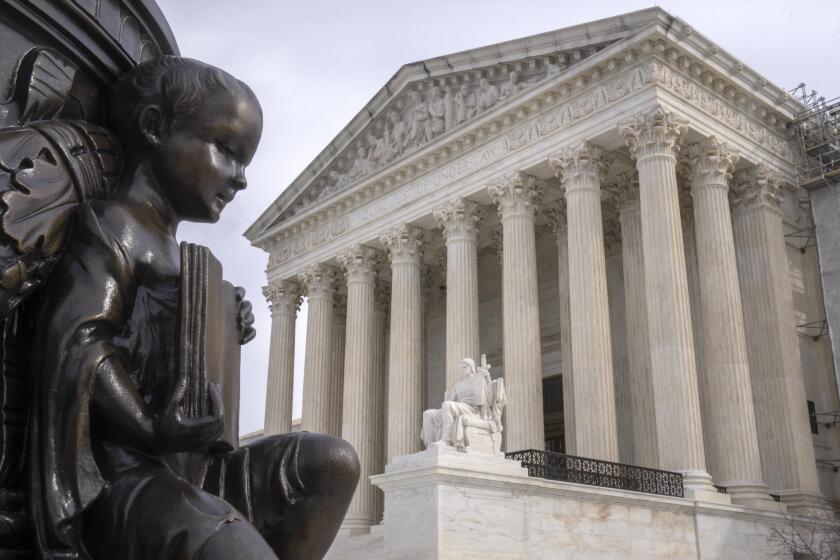Column: Man who claims to have invented email has filed a lawsuit that could put one news website out of business
- Share via
Like many technological advances, email has many fathers and mothers. But one claimant to the mantle of email’s “inventor” has spent years trying to shoulder everyone else out of the way. And now he’s filed a libel suit that could destroy one news website that has covered his campaign assiduously, and critically.
The aggrieved “inventor” is V.A. Shiva Ayyadurai, an India-born American entrepreneur. As a 14-year-old student in New Jersey in 1978, Ayyadurai devised an electronic messaging system for the University of Medicine and Dentistry of New Jersey (now Rutgers medical school) and called it “email.” A few years later, he received a copyright on his software program and the term “EMAIL.”
But does that make him the “inventor of email,” as he claims in his lawsuit? Versions of electronic messaging had been used as early as 1965 at MIT, came into their own in connection with the development of the government’s ARPANET (which evolved into the Internet) by 1972 and were being worked on in labs such as Xerox PARC through that decade.
This fight could very well be the end of Techdirt, even if we are completely on the right side of the law.
— Techdirt CEO Mike Masnick
Ayyadurai has pursued his claim to be “the man who invented email” energetically in the news media. Lately he’s taken a new tack: filing lawsuits against news organizations that challenge his claim. His most recent target is a small technology news site called Techdirt and its parent company, the Redwood City research firm Floor64.
Last month, Ayyadurai filed a $15-million libel suit against Techdirt in Boston federal court, asserting that he had been defamed by its critical reporting challenging his claim. The lawsuit says, “Dr. Ayyadurai named his computer program ‘email.’ He was the first person to create this term, because he was inventing the ‘electronic’ (or ‘e’) version of the interoffice paper-based ‘mail’ system.”
The website and its founder Mike Masnick — the author of most of the posts at issue in the case — have moved to have the lawsuit thrown out, partially on the grounds that Ayyadurai is a public figure and his activities are legitimate topics of public interest.
Techdirt says that because of its legal costs, the lawsuit has put it in a 1st Amendment “fight for its life.” In a Jan. 11 blog post aimed at drumming up public and financial support, Masnick wrote, “This fight could very well be the end of Techdirt, even if we are completely on the right side of the law.”
Ayyadurai has a high-profile attorney working on his behalf: Charles Harder, who pursued Gawker media into bankruptcy on behalf of Hulk Hogan. That lawsuit was bankrolled by Silicon Valley billionaire Peter Thiel, who had a personal gripe with Gawker. The Beverly Hills attorney also had filed a $35-million lawsuit against Gawker Media for Ayyadurai over stories on Gawker and Gizmodo, two of the company’s sites, challenging Ayyadurai’s claim; Ayyadurai received a $750,000 settlement and got the offending articles removed from the Web as part of Gawker’s demise. Harder says Thiel has nothing to do with Ayyadurai’s case. Harder also referred me to Ayyadurai’s website, which among other things provides testimonials to Ayyadurai’s intelligence from 25 sources, including his teachers, colleagues and employers, and repeats his position.
We reported on Ayyadurai in 2014 after the Huffington Post ran a five-part series broadcasting his claim. It was a heartwarming tale with an irresistible hook that began, “In 1978, a 14-year-old boy invented email.” The first article continued, “Email wasn’t created, with a massive research budget, in big institutions like the ARPANET, MIT or the military. … Email was created in the heart of inner city Newark, NJ, at a relatively small institution, with little to no funding.”
As we pointed out, however, email indeed had been created at “big institutions like the ARPANET, MIT or the military.” To the extent that any individual was given credit in the tech community as its single “inventor,” that was Ray Tomlinson of Bolt Beranek and Newman, a major contractor on the ARPANET. In 1971 or 1972, Tomlinson made refinements to existing message protocols and incorporated the use of the “@” sign as a component of message addresses. But electronic messaging systems were in vigorous development through the decade, with new features emerging such as subject lines and “cc” fields that remain familiar parts of the systems we use all day every day.
The Huffington Post eventually took down the series, some parts of which were written by people associated with the New Jersey medical university and therefore had an interest in claiming parentage for the institution. But versions of the articles live on at this website.
HuffPo wasn’t the first publisher to buy into Ayyadurai’s story. The Washington Post accepted it more or less at face value in 2012, after the Smithsonian Institution acquired some of Ayyadurai’s papers for its technology collection. The Post reported that this was tantamount to Ayyadurai’s having been “honored by [the] Smithsonian” as the “inventor of e-mail,” but that wasn’t true, and the newspaper eventually retracted the assertion. The Post’s then-ombudsman, Patrick Pexton, snarkily defended the original article without doing his homework, and then had to run his own retraction. The Post was followed down this rabbit hole by then-New York Times tech columnist David Pogue, who accepted Ayyadurai’s version of history for a tweet a few months later. Then he ran a retraction, stating that he had been “snookered.”
As technologists and Web historians have written, the true history of email is one of repeated, organic iterations of fundamental systems, much of which took place years before Ayyadurai’s work. A paper by historian Thomas Haigh of the University of Wisconsin, chairman of the Special Interest Group on Computers, Information, and Society, and published on the SIGCIS website, describes versions of electronic mail dating back to the 1960s with features such as “to,” “cc” and “bcc” fields that became part of a “binding standard” in 1977, prior to Ayyadurai’s work at Rutgers. A December 1977 Rand Corp. paper by engineer David Crocker, commissioned by the Defense Advanced Research Projects Agency, or DARPA, identifies “electronic mail” as “one of the earliest and most popular applications of the ARPANET” and includes sample emails virtually indistinguishable from modern messages.
Haigh writes that Queen Elizabeth II became the first head of state to send electronic mail in 1976, Jimmy Carter’s campaign team used electronic mail for internal communication that year and by 1978, email was sufficiently widespread that the first spam went out inadvertently to 600 users that May.
The history of email is capacious enough to accommodate hundreds of inspired engineers and scientists. Ayyadurai merits acknowledgment as a contributor to this rich pageant, especially given the talent he showed at 14. But no one should claim to be the inventor of such a multifaceted, evolutionary system, and Ayyadurai should stop trying.
Keep up to date with Michael Hiltzik. Follow @hiltzikm on Twitter, see his Facebook page, or email [email protected].
Return to Michael Hiltzik’s blog.







